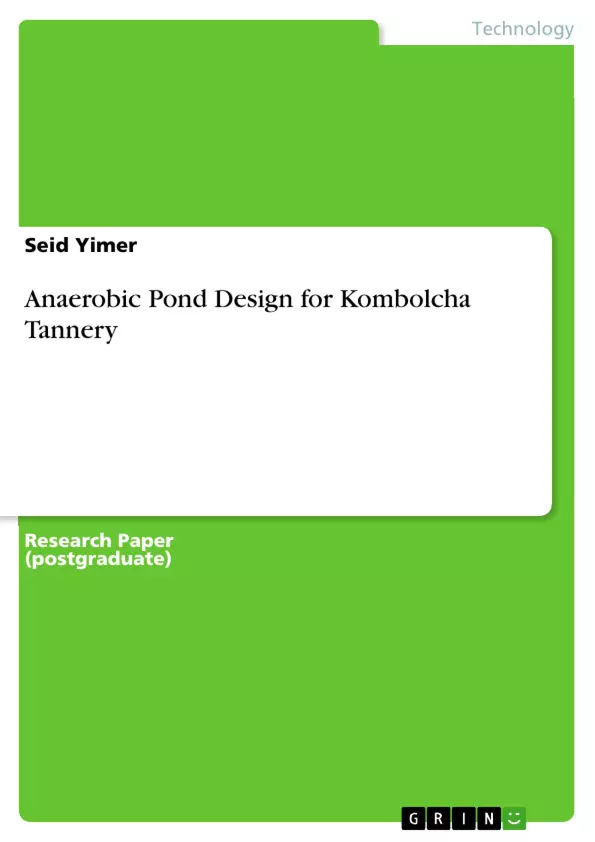Waste is the most horrible thing to our environment especially a waste from tannery industries. Kombolcha tannery since it is part of these industries it is affecting the people and brings drastic chance to the environment. Since this is the fact those treatment techniques are necessary to the factory like the one mentioned. In this study an aerobic pond is designed for tannery waste. It is possible to make suitable to our environment by treating it as per the type of the waste and degree of toxicity and hazard. This will be practiced only when the industrialists put themselves in to the boundaries of the industrial legislation otherwise good things will not happen unless the bad situation are developed. For the treatment techniques the one which has lower installation cost and lower running cost were used.
Key Words: Anaerobic pond, Tannery waste, Hazard
Inhaltsverzeichnis (Table of Contents)
- Acknowledgement
- Table of Contents
- List of Acronyms
- Abstract
- 1. Introduction
- 1.1 Background
- 1.2 Objectives
- 1.2.1 General Objectives
- 1.2.2 Specific Objectives
- 2. Waste in Leather Industry
- 2.1 Solid Waste
- 2.2 Effluents
- 2.3 Harmful Effects of Pollutant Present in Tannery Waste
- 2.3.1 Chromium
- 2.3.2 Sulfide
- 2.3.3 Organic
- 2.3.4 Suspended Mater
- 2.3.5 PH
- 3. Tanning of Leather
- 3.1 Origin and Properties of Tanning Material
- 3.1.1 Trimming
- 3.1.2 Washing and Soaking
- 3.1.3 Liming
- 3.1.4 Fleshing
- 3.1.5 Deliming and Bating
- 3.1.6 Pickling
- 3.1.7 Chrome Tanning
- 4. Waste Stabilization Ponds
- 4.1 Application of Waste Stabilization Pond Systems
- 4.2 Types of waste stabilization pond
- 4.2.1 Aerobic Ponds
- 4.2.2 Facultative Pond
- 4.2.3 Maturation ponds
- 5. Anaerobic Ponds
- 5.1 Description of Anaerobic Pond
- 5.2 Treatment Mechanisms
- 5.3 Advantages and Disadvantages of Anaerobic Ponds
- 5.3.1 Advantages
- 5.3.2 Disadvantages
- 6. General Material Balance
- 6.1 Summary of the Material Balance
- 7. Pond Design
- 7.1 Flow Chart for the Treatment of Tanning Waste Water
- 7.2 Screen Design
- 7.3 Anaerobic Pond Design
- 7.4 Facultative Pond
- 7.5 Maturation Pond
- 7.6 Detail Design of Anaerobic Pond
- 7.7 Inlet outlet structure of anaerobic pond
- 8. Pond Layout
- 8.1 Pond Geometry
- 8.2 Inlet and Outlet Structure
- 8.3 Inlet Outlet Structure of Anaerobic Pond
- 9. Chrome Removal in Anaerobic Pond
- 9.1 Site Selection
- 10. Cost Analysis
- 11. Conclusion and Recommendation
- 11.1 Conclusion
- 11.2 Recommendation
- References
Zielsetzung und Themenschwerpunkte (Objectives and Key Themes)
This research investigates the design of an anaerobic pond for treating wastewater from the Kombolcha Tannery in Ethiopia. The study aims to develop a comprehensive design for an anaerobic pond system that effectively reduces pollutants and meets environmental regulations.
- Wastewater Treatment
- Anaerobic Pond Design
- Environmental Regulations
- Tannery Waste Characterization
- Sustainable Wastewater Management
Zusammenfassung der Kapitel (Chapter Summaries)
- Chapter 1: Introduction: This chapter introduces the research topic, providing background information about the leather industry and the challenges associated with tannery wastewater. It also outlines the research objectives.
- Chapter 2: Waste in Leather Industry: This chapter delves into the various types of waste generated by the leather industry, focusing on solid waste and effluents. It examines the harmful effects of pollutants commonly found in tannery wastewater, including chromium, sulfide, organics, suspended solids, and pH.
- Chapter 3: Tanning of Leather: This chapter explores the different stages involved in leather tanning, explaining the origins and properties of tanning materials. It covers processes such as trimming, washing, soaking, liming, fleshing, deliming, bating, pickling, and chrome tanning.
- Chapter 4: Waste Stabilization Ponds: This chapter discusses the application and types of waste stabilization pond systems, including aerobic, facultative, and maturation ponds. It highlights the principles and advantages of each type.
- Chapter 5: Anaerobic Ponds: This chapter focuses on anaerobic ponds, describing their characteristics, treatment mechanisms, and advantages and disadvantages. It provides a comprehensive overview of the anaerobic digestion process.
- Chapter 6: General Material Balance: This chapter presents a summary of the material balance for the tannery wastewater treatment process, considering the input and output of different components.
- Chapter 7: Pond Design: This chapter outlines the design process for the anaerobic pond system, including flow chart development, screen design, and the specific design of the anaerobic, facultative, and maturation ponds. It also includes a detailed design of the anaerobic pond and its inlet and outlet structures.
- Chapter 8: Pond Layout: This chapter covers the overall layout of the pond system, including pond geometry, inlet and outlet structures, and the specific design of the anaerobic pond's inlet and outlet.
- Chapter 9: Chrome Removal in Anaerobic Pond: This chapter discusses the removal of chromium in the anaerobic pond, including site selection considerations.
- Chapter 10: Cost Analysis: This chapter presents a detailed cost analysis for the anaerobic pond system, outlining the associated expenses.
Schlüsselwörter (Keywords)
This research focuses on the design of an anaerobic pond for treating wastewater from the Kombolcha Tannery. Key terms and concepts include tannery wastewater, anaerobic digestion, waste stabilization ponds, chromium removal, environmental regulations, and sustainable wastewater management.
- Quote paper
- Lecturer Seid Yimer (Author), 2013, Anaerobic Pond Design for Kombolcha Tannery, Munich, GRIN Verlag, https://www.grin.com/document/209509



